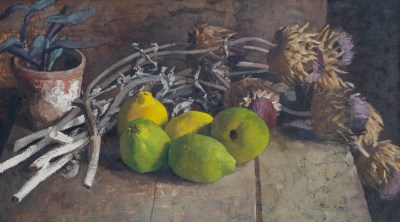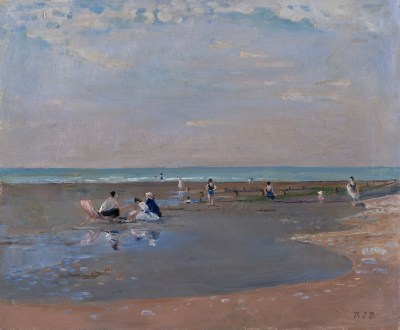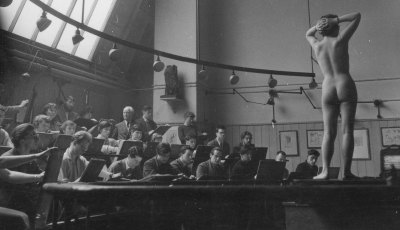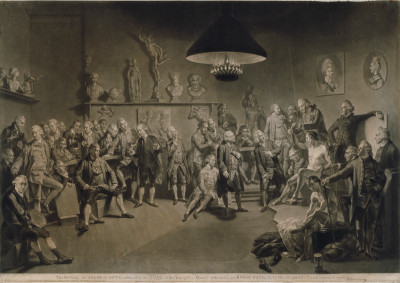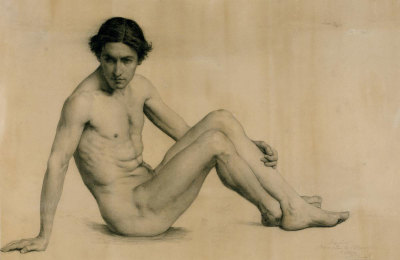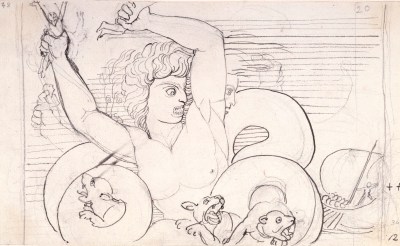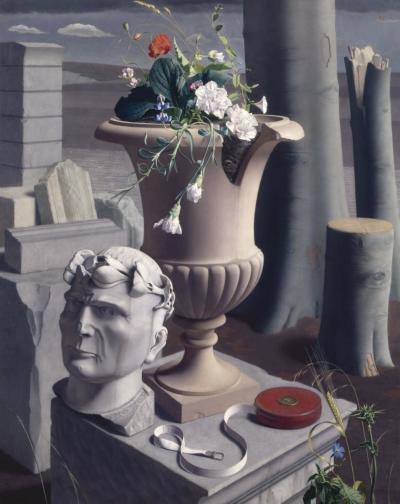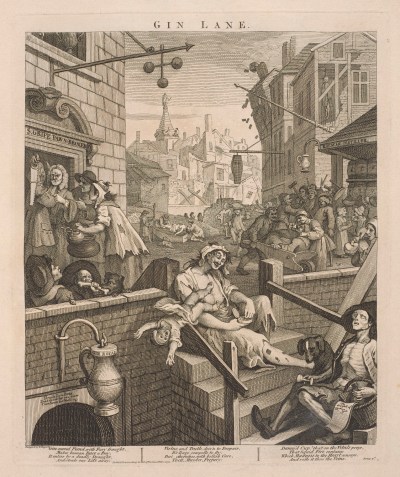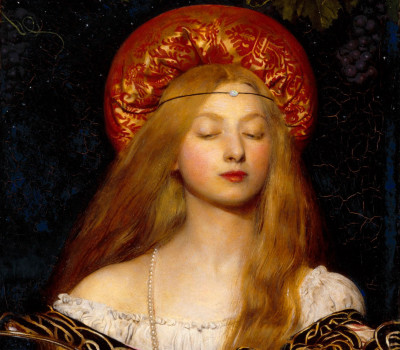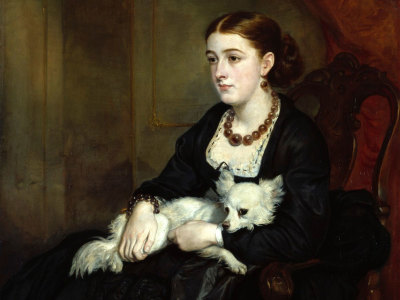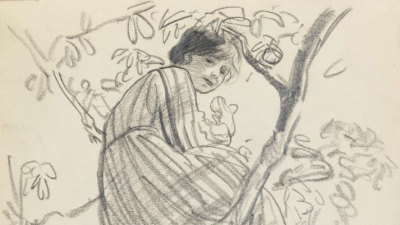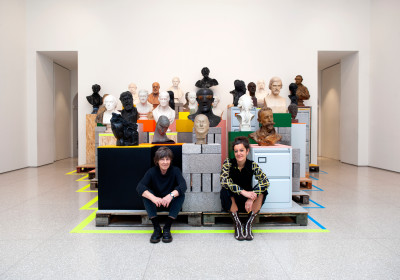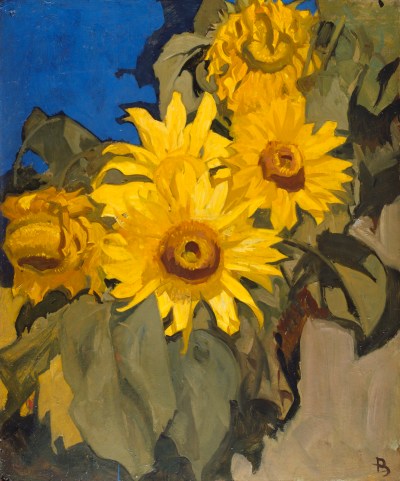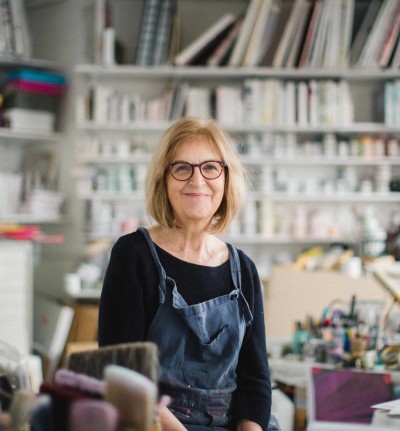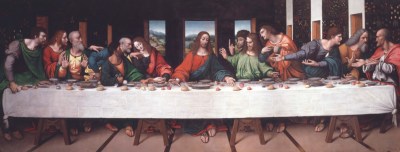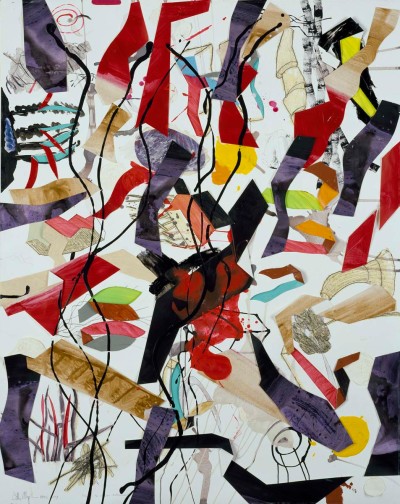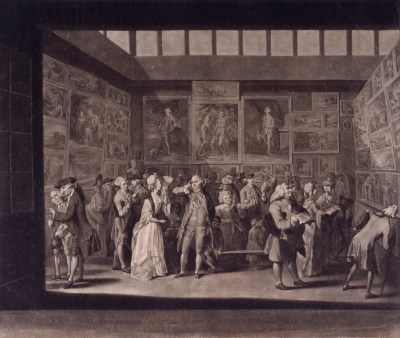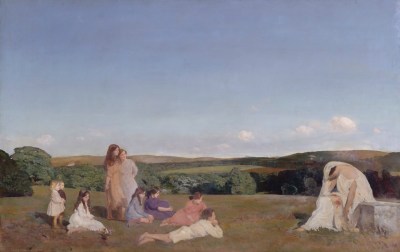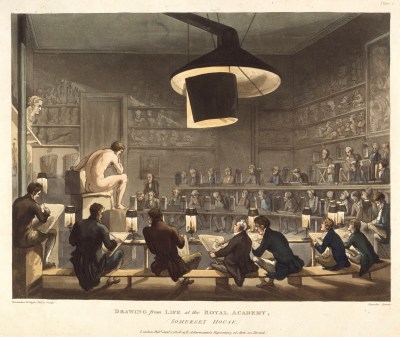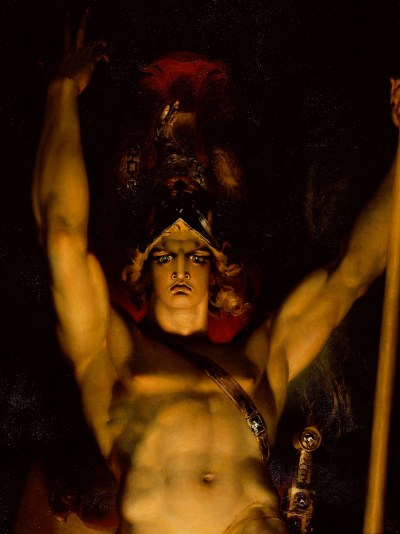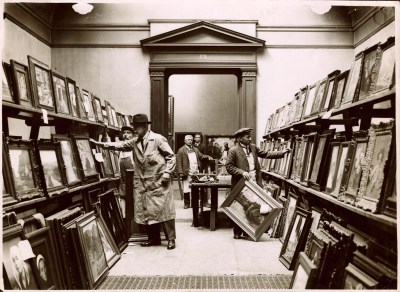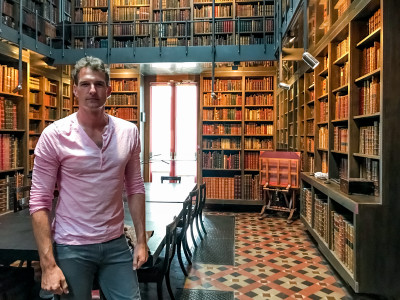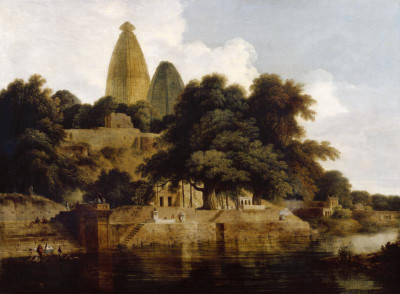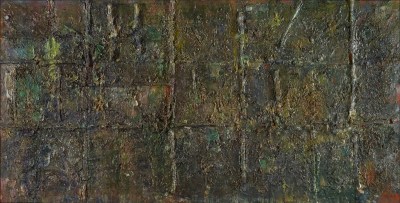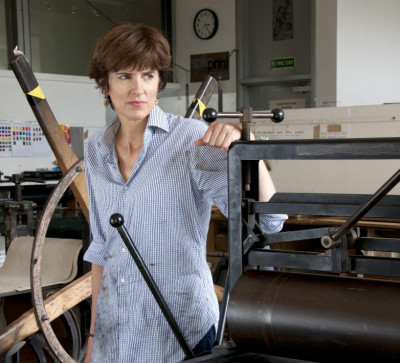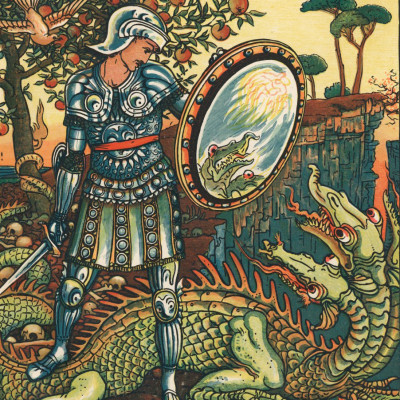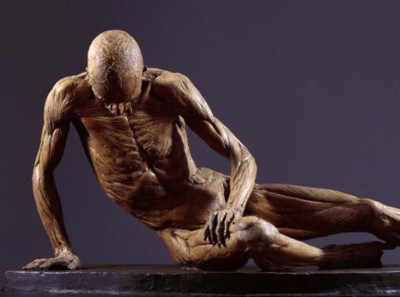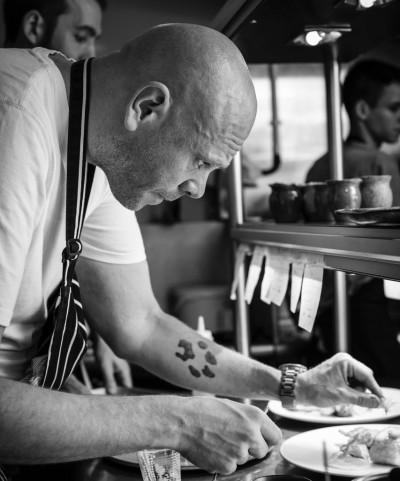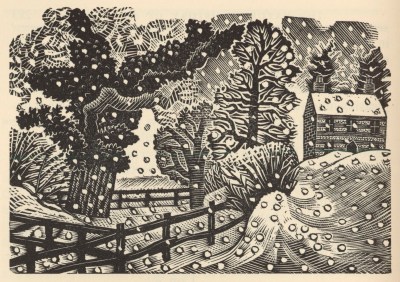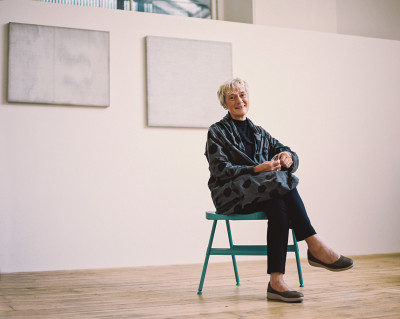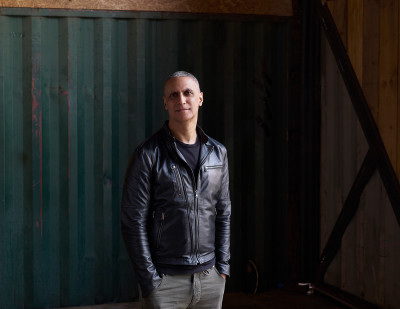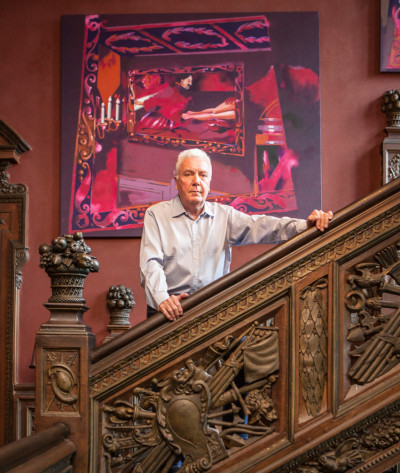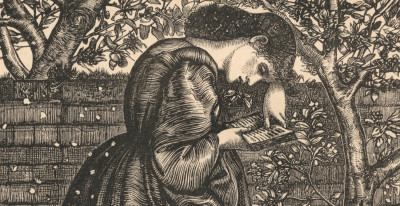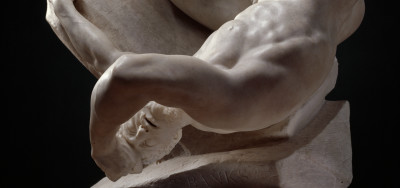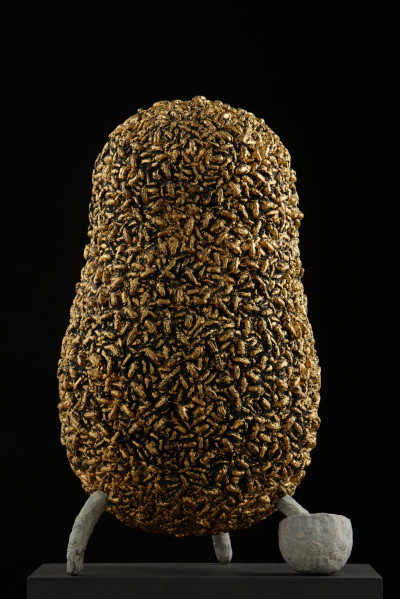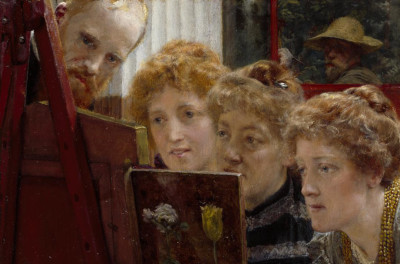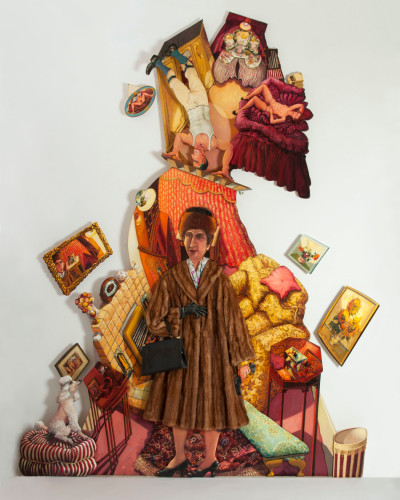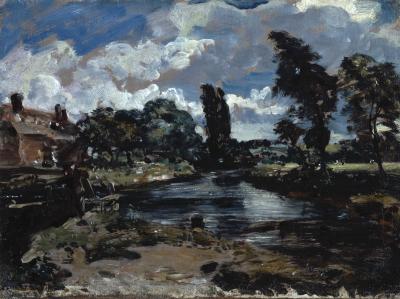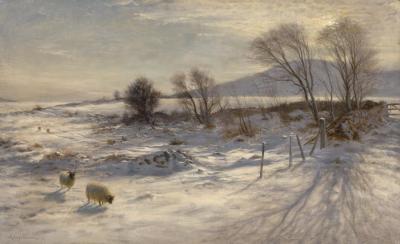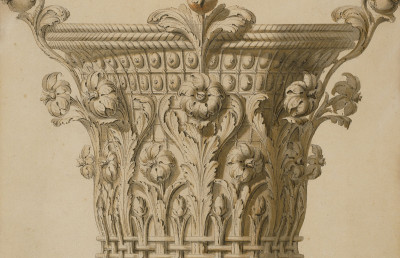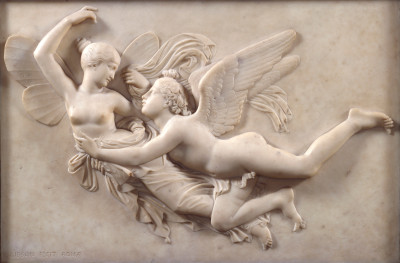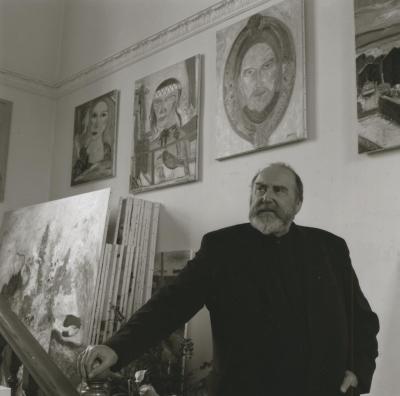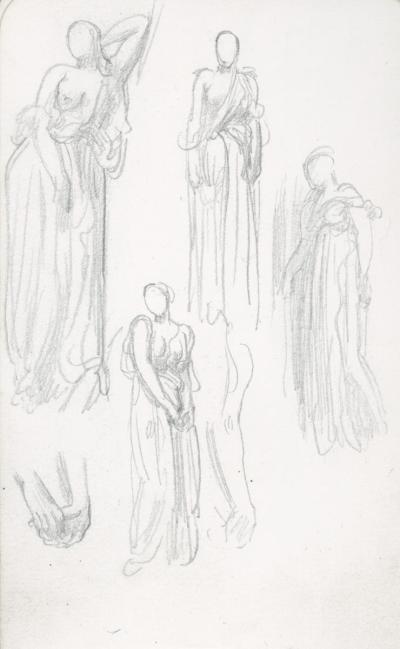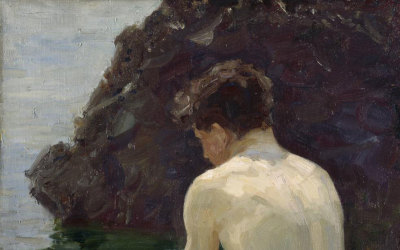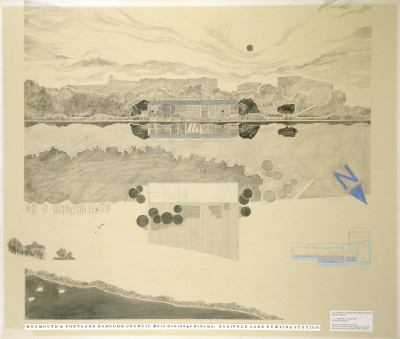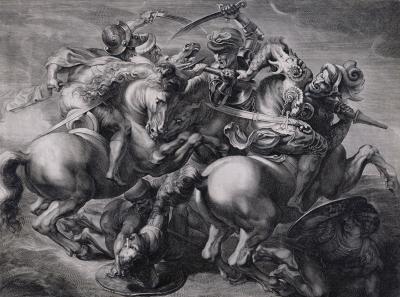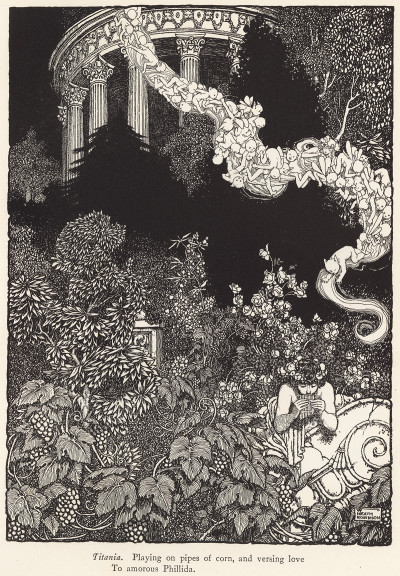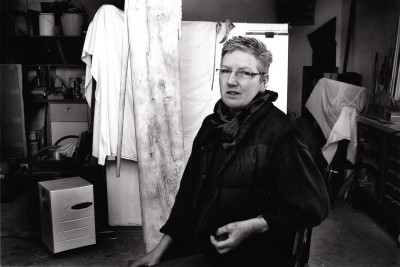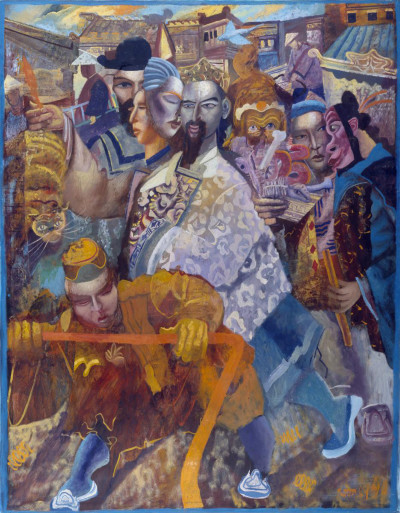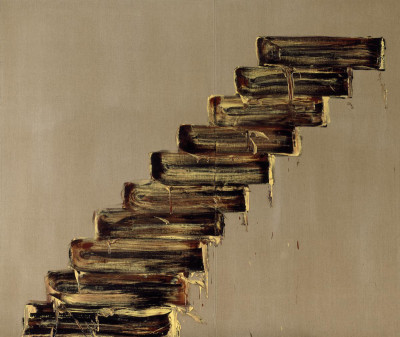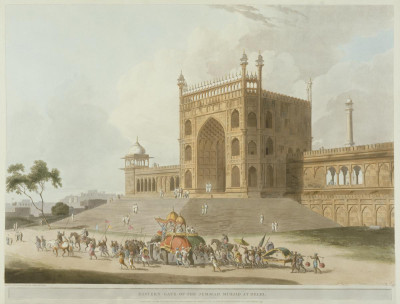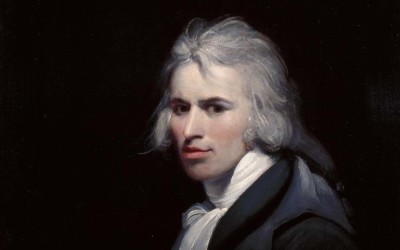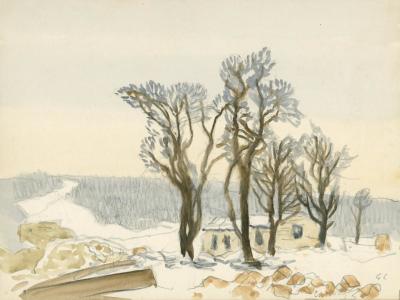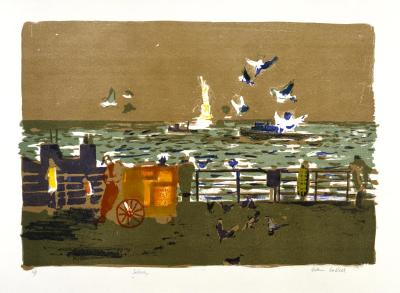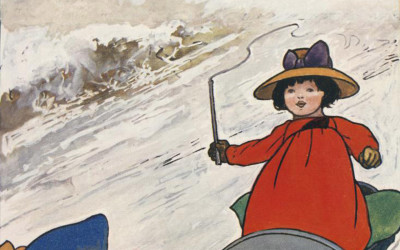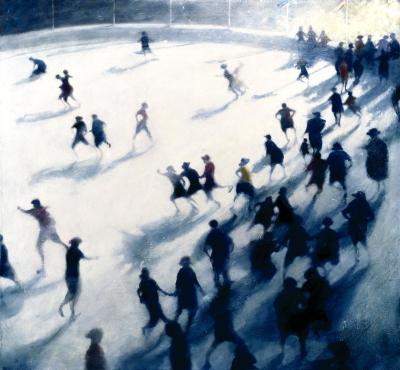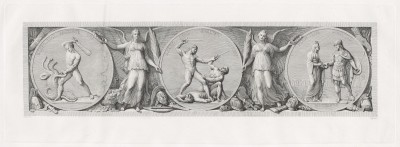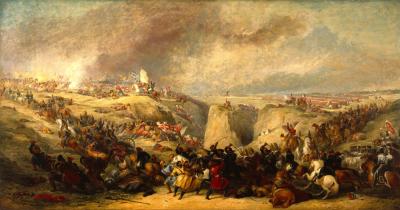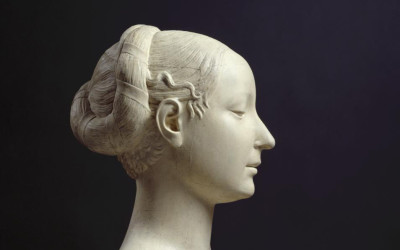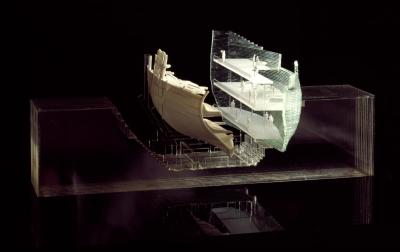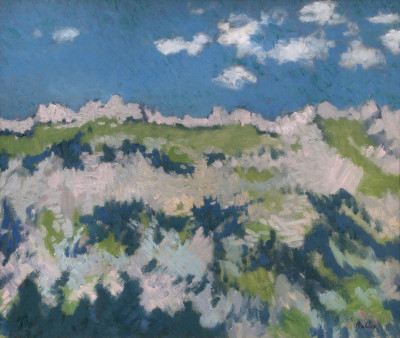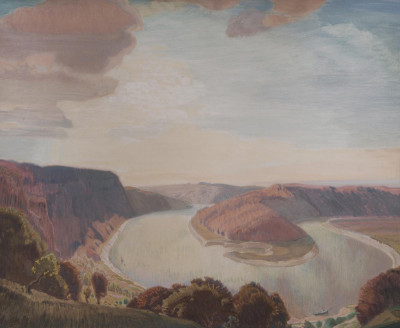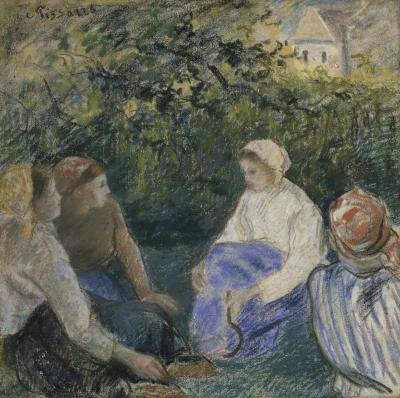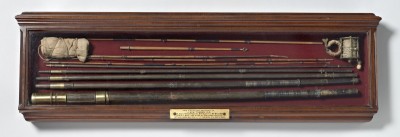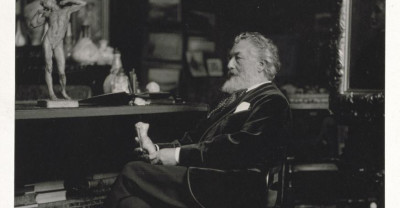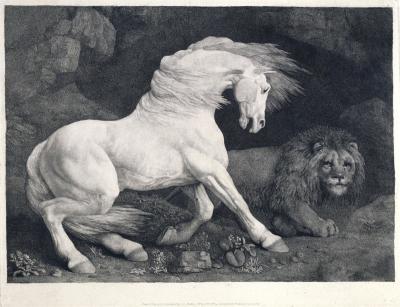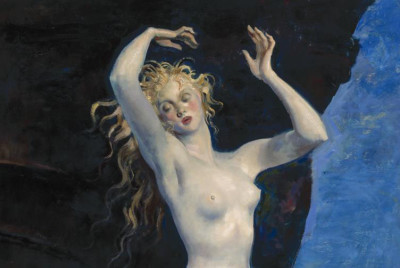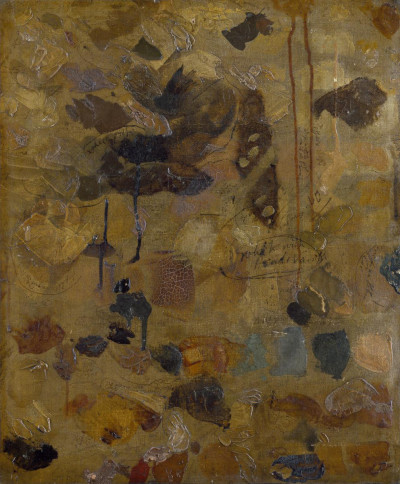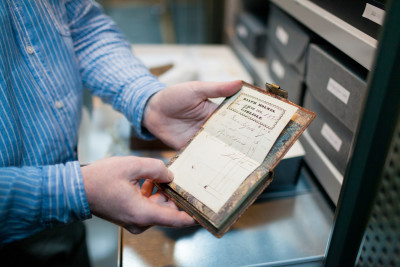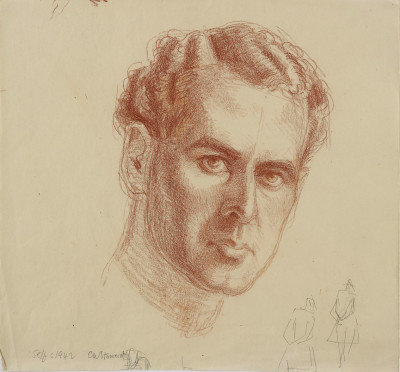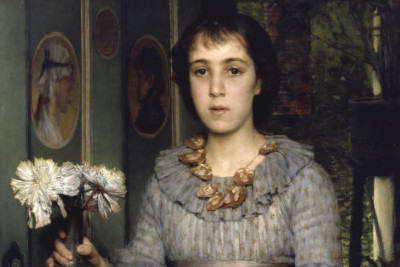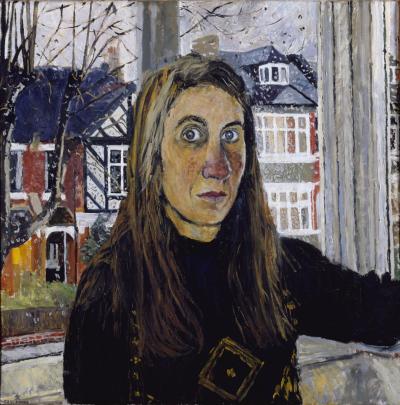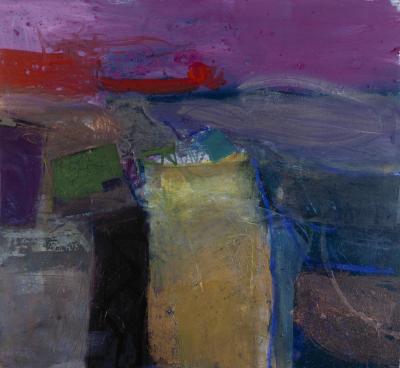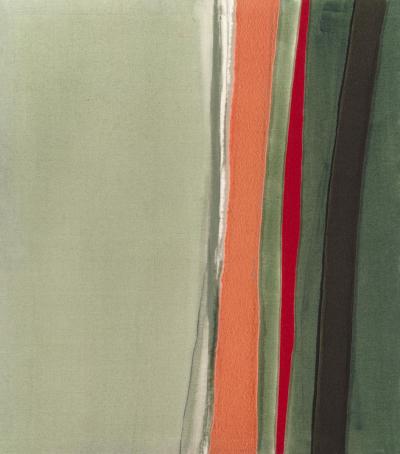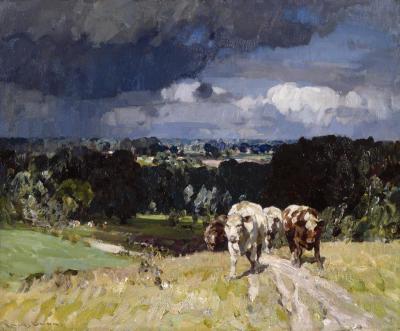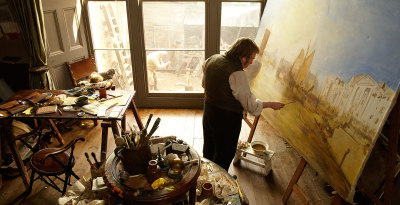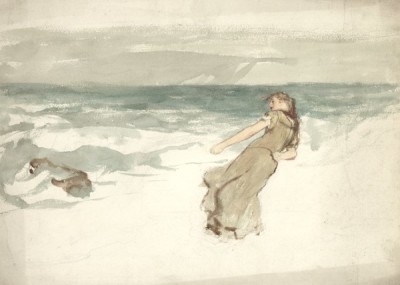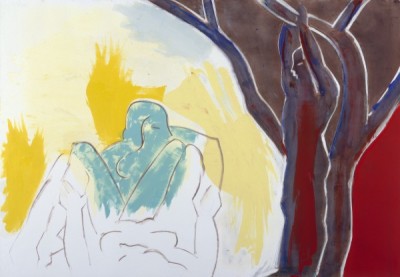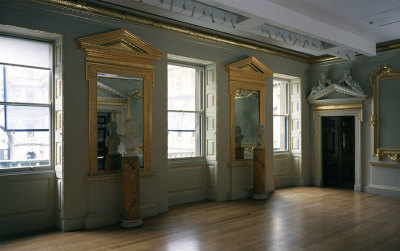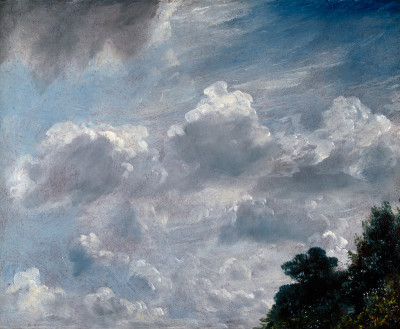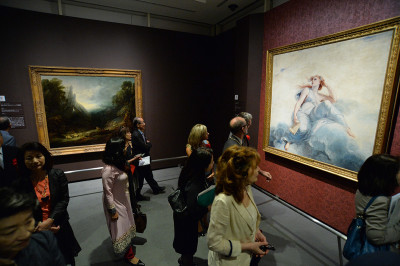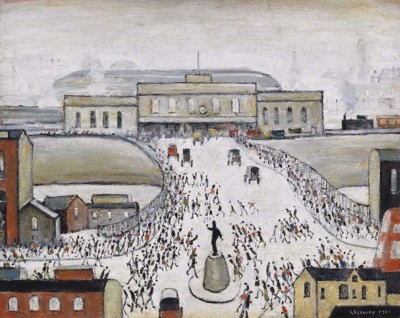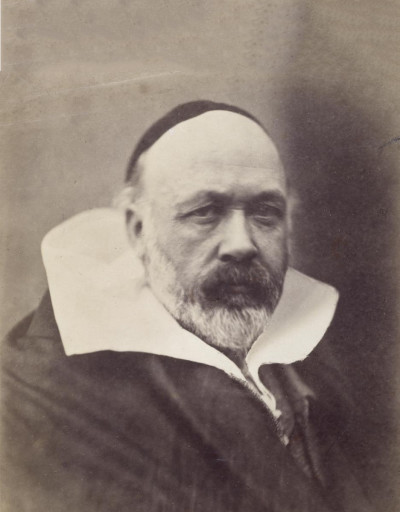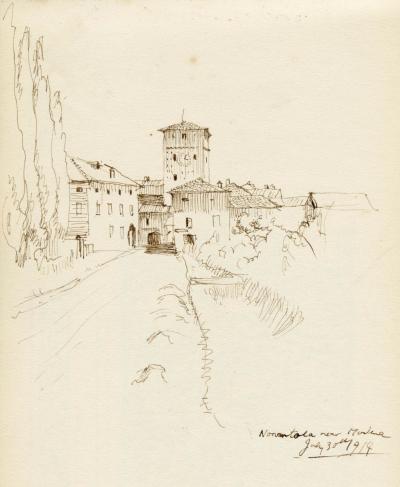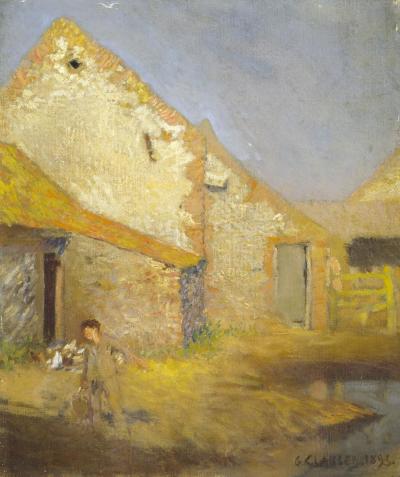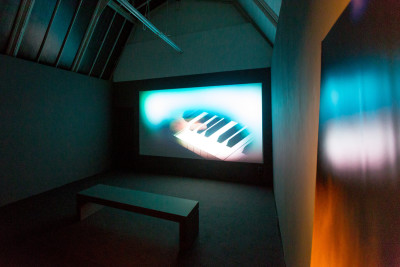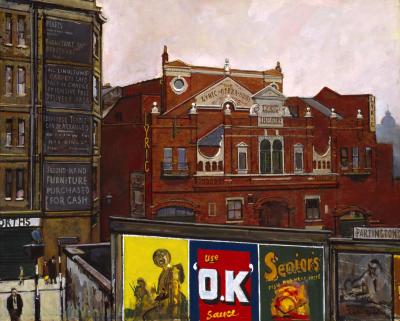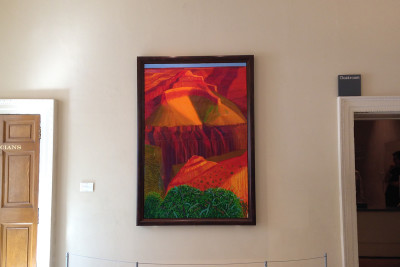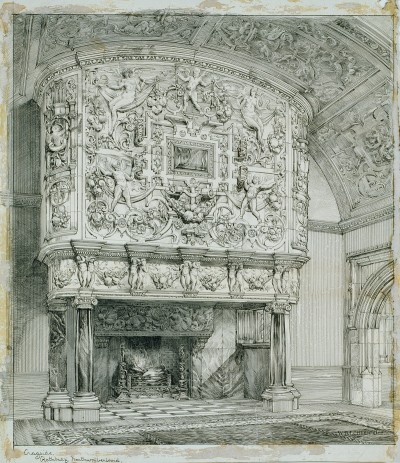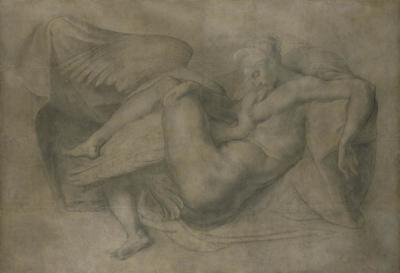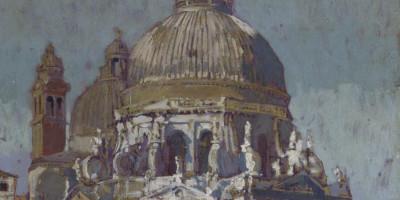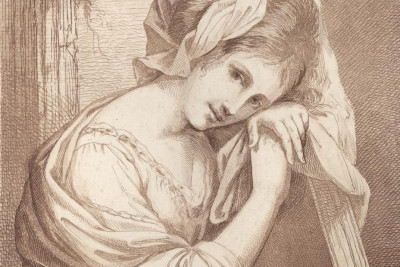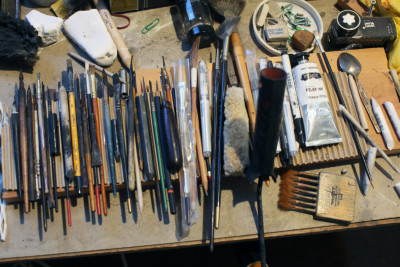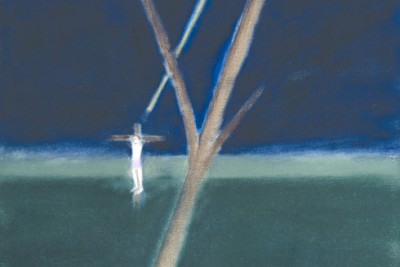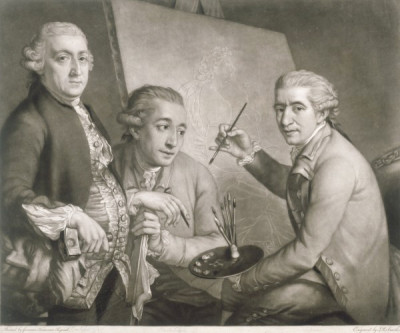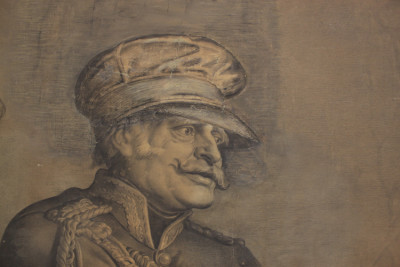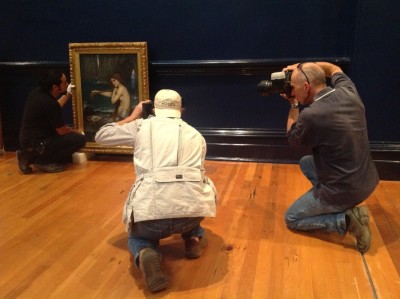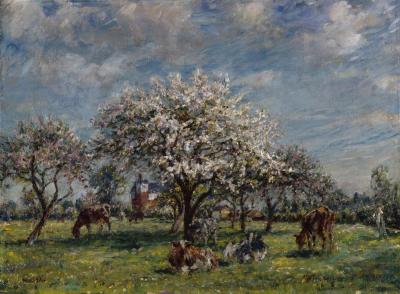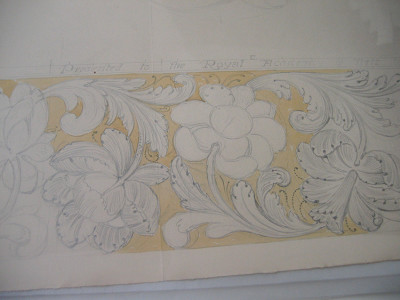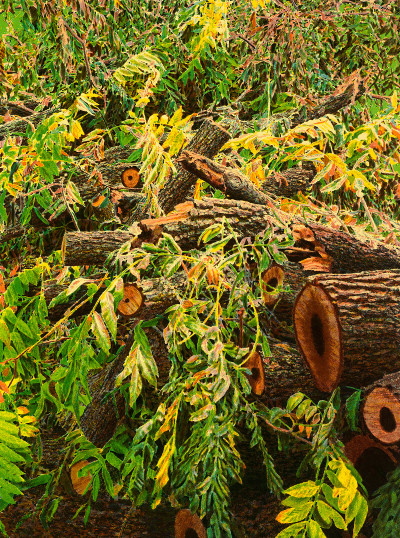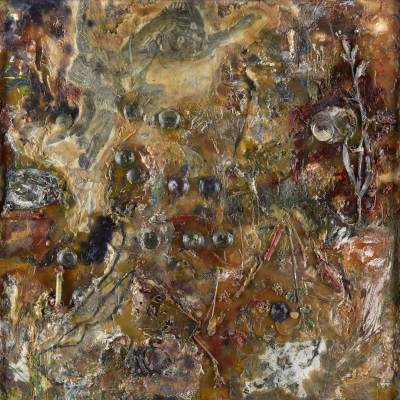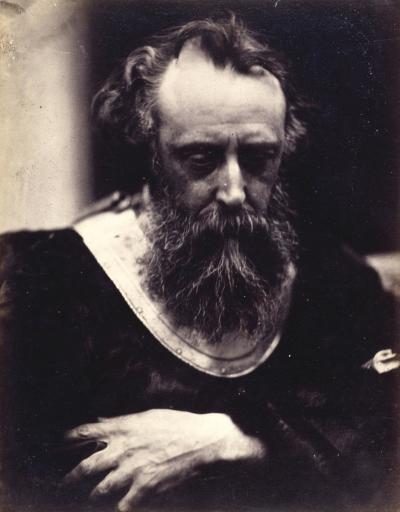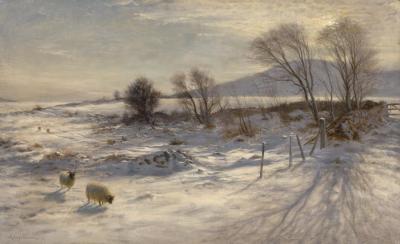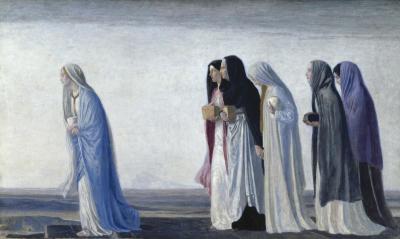Search the Collection
Search the Collection
Look for people, works of art, books, archive materials, exhibition catalogues and frames from within the RA Collection.
-
Highlights from the Collection

Sir Joshua Reynolds PRA, Theory, 1779-1780.
Part of the RA CollectionOil on canvas. 1780 mm x 1790 mm. © Photo: Royal Academy of Arts, London.

Angelica Kauffman RA, Design, 1778-80.
Part of the RA CollectionOil on canvas. 1260 mm x 1485 mm x 25 mm. © Photo: Royal Academy of Arts, London. Photographer: John Hammond.

Thomas Banks RA, The Falling Titan, 1786.
Part of the RA CollectionMarble. 845 mm x 902 mm x 584 mm, Weight: 265 kg. © Photo: Royal Academy of Arts, London. Photographer: Paul Highnam.

John Constable RA, The Leaping Horse, 1825.
Part of the RA CollectionOil on canvas. 1420 mm x 1873 mm. © Photo: Royal Academy of Arts, London. Photographer: Prudence Cuming Associates Limited.

Sir John Everett Millais Bt. PRA, A Souvenir of Velazquez, 1868.
Part of the RA CollectionOil on canvas. 1027 mm x 824 mm. © Photo: Royal Academy of Arts, London. Photographer: John Hammond.

Dame Laura Knight RA, A Misty Sunrise, By 1956.
Part of the RA CollectionOil on canvas. 760 mm x 960 mm x 28 mm. © The Artist's Estate. © Photo: Royal Academy of Arts, London.

Sir Anthony Caro RA, Cascade Series 'Mouchoir', 1990.
Part of the RA CollectionSteel (rusted & waxed). 1395 mm x 1395 mm x 1115 mm. © Sir Anthony Caro RA. © Photo: Royal Academy of Arts, London. Photographer: Paul Highnam.

Tracey Emin RA, Trying to Find You 1, 2007.
Part of the RA Collectionacrylic on canvas. 210 mm x 298 mm x 26 mm. © Tracey Emin RA. © Photo: Royal Academy of Arts, London. Photographer: Prudence Cuming Associates Limited.
-
Read more about our Collection
-

Our Collection
2 days ago
Creative inspiration today from the first President of the Royal Academy
The RA’s founding President Joshua Reynolds may have shaken up the art world when he delivered his ‘Discourses’ lectures, but are they still relevant now? We take a closer look at what artists and art-lovers can learn from the series today.
-

Our Collection
9 days ago
Video: Apocalyptic printmaking and extreme environments with Emma Stibbon RA
Watch Emma Stibbon describes the unforgiving conditions and dramatic landscapes that inspired her display in the Collection Gallery.
-

Our Collection
11 months ago
RA Collections Decolonial Research Project
Over the past year, our team has been investigating the links between the RA and its colonial past. In our first post on this subject, we offer an update on this work, and capture how we’re documenting associations between 18th- and 19th-century Royal Academicians and colonial activities
-

Our Collection
< 2 years ago
A slow look: Yinka Shonibare’s ‘Cheeky Little Astronomer’
Take ten minutes to meditate as we guide you through a slow, mindful look at Yinka Shonibare RA’s sculpture.
-

Our Collection
< 2 years ago
A slow look: Oriana Reinagle’s ‘Study of trees’
Enjoy five blissful minutes of mindfulness and art with this guided meditation.
-

Our Collection
< 2 years ago
A slow look: John Aldridge’s ‘Artichokes and Cathay Quinces’
Take ten minutes to meditate as we mindfully guide you through John Aldrige’s still life painting ‘Artichokes and Cathay Quinces’.
-

Our Collection
< 2 years ago
A slow look: Rodney Burn’s ‘Bracklesham Sands’
Spend 10 mindful minutes on a guided meditation through the details of Rodney Burn RA’s ‘Bracklesham Sands’.
-

Our Collection
2 years ago
Naked truth: the story of female life models at the RA
What does a 230-year-old household bill tell us about life modelling in the 18th-century? Here, we explore the historical role of the female nude life model at the RA.
-

Our Collection
2 years ago
Mary Moser and Angelica Kauffman: the RA’s founding women
Angelica Kauffman and Mary Moser were the only two female founders of the Royal Academy. Here, we take a closer look at their careers and the challenges they faced within the RA.
-

Our Collection
2 years ago
Victorian women and the fight for arts training
19th-century women faced an uphill struggle to get equal access to training at the Royal Academy Schools. Here, we delve into the RA Archive to learn more about women’s fight for equality.
-

Our Collection
2 years ago
In 60 seconds: Waterhouse’s ‘A Mermaid’
Spend 60 seconds exploring the dark mythology behind John William Waterhouse RA’s ‘A Mermaid’.
-

Our Collection
> 2 years ago
7 life drawing shorts to do at home
In 2018, we hosted the world’s first-ever livestreamed life drawing class from the Royal Academy’s famous Life Room, #LifeDrawingLive. Grab a pencil and have a crack at each pose by life model Andrew Crayford.
-

Our Collection
> 2 years ago
How to read it: Flaxman’s ‘The Iliad’ and ‘The Odyssey’
The 18th-century British artist John Flaxman was an established sculptor, but it was his drawn illustrations of ‘The Iliad’ and ‘The Odyssey’ that made him a sensation across Europe.
-

Our Collection
> 2 years ago
How to read it: Annie Swynnerton’s The Letter
In 1922, the Royal Academy elected its first female member in over 150 years, Annie Swynnerton – here’s how to read her enigmatic painting of a young woman.
-

Our Collection
< 3 years ago
How to read it: Meredith Frampton’s Still Life
This meticulous and mysterious work by Meredith Frampton is full of contrasting symbolism. Our Collections team guide you through it in this three-minute read.
-

Our Collection
< 3 years ago
In 60 seconds: Shonibare’s ‘Cheeky Little Astronomer’
Discover how multicultural influences fuse together to create a wider view of global inclusivity in Yinka Shonibare RA’s cheeky sculpture.
-

Our Collection
< 3 years ago
In 60 seconds: Hogarth’s ‘Gin Lane’ & ‘Beer Street’
Learn how a pair of engravings by satirical artist William Hogarth were used to alter the drinking habits of the British public in the 18th century.
-

Our Collection
< 3 years ago
How to read it: Frank Cadogan Cowper’s Vanity
Combining allusions to both Renaissance and Pre-Raphaelite painting, Frank Cadogan Cowper’s Vanity celebrates beauty while cautioning against excessive self-regard. Unravel the painting’s influences in this three-minute read.
-

Our Collection
< 3 years ago
The RA Collection in 250 Objects: Doodles
Doodling is not a modern phenomenon. Artists throughout time have let their minds wander, distracted in meetings or at dinners, filling pages with odds and ends of experimental creativity. As the coronavirus keeps many of us in our homes, we’ve uncovered 10 of our favourite doodles from the RA Collection for use as inspiration for the daily doodle challenges on our Twitter.
-

Our Collection
< 3 years ago
The RA Collection in 250 Objects: Dogs
This one’s for dog and art-lovers everywhere, as well as the cat people yet to be converted. We went for walkies through our Collection and found a pack of misfit mutts, and perfect pooches depicted by artists across the centuries. Here is a selection showing that today’s obsession with cute dog pics has its roots in art history.
-

Our Collection
3 years ago
The RA Collection in 250 Objects: Self-Portraits
Inspired by our exhibition ‘Lucian Freud: The Self-Portraits’, we looked through the RA Collection to find self-portraits by our own Academicians. From conventional portrayals of the artist at work to some more unusual manifestations of the self – here are the 10 top self-portraits from the RA Collection.
-

Our Collection
3 years ago
How to read it: Dame Laura Knight RA’s ‘Ella Naper in the Apple Orchard at Trewoolfe’
Dame Laura Knight RA was denied access to nude models throughout her studies. In Cornwall, she found the freedom and the friends to make up for lost time.
-

Our Collection
> 3 years ago
Artists Cathie Pilkington and Alison Wilding on ‘The Ancestors’
Fiona Maddocks meets the former teacher and pupil duo about their co-curated project on their Academy forebears.
-

Our Collection
> 3 years ago
How to read it: Gabriella Boyd’s “Sunhead”
In Gabriella Boyd’s “Sunhead”, familiar shapes are given a surreal twist. The painting floats on the edge of reality where nothing is certain. But what does it mean? Where did the head go? And why is this painting in the RA’s Collection anyway?
-

Our Collection
> 3 years ago
How to read it: Frank Brangwyn’s ‘Sunflowers’
Frank Brangwyn’s ‘Sunflowers’ is an explosion of colour that captures the vibrancy of a much-loved plant. But did Brangwyn copy Van Gogh? And why sunflowers, anyway?
-

Our Collection
< 4 years ago
Mali Morris RA Top picks from the Collection
Currently on show in the RA’s Collections Gallery cabinet is a selection of works from our collection, curated by Mali Morris RA. Here, the abstract painter and Royal Academician talks us through some of the works she’s chosen for the display.
-

Our Collection
< 4 years ago
How to read it: our copy of Leonardo’s Last Supper
Within the RA’s Collection Gallery is a full-size copy of Leonardo da Vinci’s ‘Last Supper’, painted by one or more of his pupils. What can it tell us about the original masterpiece?
-

Our Collection
> 4 years ago
The RA in 250 objects: War
As the RA turns 250 years old, we’re exploring 250 beautiful, odd and inspiring objects from the RA Collection in 25 themes. In this edition, we mark 100 years since the Armistice, looking at how artists have experienced war and conflict over the centuries.
-

Our Collection
> 4 years ago
The RA Collection in 250 objects: Architecture
To celebrate our 250th birthday, we’re exploring 250 beautiful, odd and inspiring objects from the RA Collection in 25 themes. With an exhibition of the architect Renzo Piano currently taking place at the RA, in this online exhibition we look at the some of the architectural works in the RA collection, from models to poems.
-

Our Collection
> 4 years ago
Top picks from the RA Collection: Tamara Rojo
As the dancer and Artistic Director of English National Ballet speaks at the RA’s first Festival of Ideas, we caught up with Tamara Rojo to hear about the art that has inspired and intrigued her – from the work she used to prepare for dancing Swan Lake, to the painting she dreams of owning.
-

Our Collection
> 4 years ago
How to read it: The Exhibition of the Royal Academy in Pall Mall, 1771
How much has the Summer Exhibition changed in 250 years? As the Great Spectacle exhibition looks back at the masterpieces from its history, we head back to 1771 to explore a work that documented the exhibition itself.
-

Our Collection
> 4 years ago
The RA Collection in 250 objects: The Summer Exhibition
To celebrate our 250th birthday, we’re highlighting 250 beautiful, odd and inspiring objects from the RA Collection in 25 themes. In this edition, with the Summer Exhibition on display, and another RA exhibition – The Great Spectacle – looking back at its history, we explore some works in the Collection from Summers gone by.
-

Our Collection
> 4 years ago
The RA Collection in 250 objects: How artists learned to draw
For our 250th birthday, we highlighted 250 beautiful, odd and inspiring objects from the RA Collection in 25 themes. With a free display exploring how artists have traditionally learnt to draw, in this edition we head into the Royal Academy’s historic schools…
-

Our Collection
> 4 years ago
‘Deeds not words’: Suffragettes and the Summer Exhibition
The Great Spectacle charts 250 years of Summer Exhibitions – including 1914, when Suffragette Mary Wood attacked a John Singer Sargent portrait with a meat cleaver. We delve into the Royal Academy’s archive to find out how the Academy, and the public, reacted.
-

Our Collection
> 4 years ago
The RA Collection in 250 objects: Dance
To celebrate our 250th birthday, we’re highlighting 250 beautiful, odd and inspiring objects from the RA Collection in 25 themes. In this edition we put on our dancing shoes to tap, twirl and stomp our way from antiquity to today.
-

Our Collection
> 4 years ago
How to read it: Thomas Lawrence’s Satan Summoning his Legions
As you enter the RA’s new Collection Gallery, a very large (and slightly absurd) figure of Satan towers over you – in what looks suspiciously like the Tory “power stance”. Here’s the story behind the painting…
-

Our Collection
< 5 years ago
The RA Collection in 250 objects: Clouds
To celebrate our 250th birthday, we’re highlighting 250 beautiful, odd and inspiring objects from the RA Collection in 25 themes. In this edition – inspired by the beautiful cloud drawings of Tacita Dean, currently on display in her ‘LANDSCAPE’ exhibition – take a few minutes to drift through the clouds that have been etched, sketched, printed and painted throughout history.
-

Our Collection
< 5 years ago
Quiz: which great British artwork are you?
To celebrate our 250th birthday, we’re finally putting the treasures of our Collection on free display all across the RA. Each artwork has its own unique character, so which one matches yours?
-

Our Collection
< 5 years ago
Top picks from the Collection: Mary Beard’s mythology trail
To celebrate our Collection going on display for the first time, we asked our Professor of Ancient Literature, Mary Beard, to tell us the stories behind some of her favourite pieces inspired by classical myths – from Hercules and Venus to lesser-known gods, nymphs and cyclopes. You’ll find all these works on free display in the new RA.
-

Our Collection
< 5 years ago
Top picks from the Collection: Dan Snow
Epic conflicts, mythical heroes and a quiet bit of fishing all feature in historian Dan Snow’s favourite objects from the RA Collection. Listen as he recaps the Battle of Waterloo, explains the ingenious WWI ‘Dazzle’ designs and muses on a deathbed olive branch extended from Gainsborough to Reynolds.
-

Our Collection
< 5 years ago
The RA Collection in 250 objects: Around the World
To celebrate our 250th birthday this year, we’re highlighting 250 beautiful, odd and inspiring objects from the RA Collection across 25 themes. In this edition, we’re setting forth across the seven seas to discover works by artists who voyaged across the globe, drawing what they saw.
-

Our Collection
< 5 years ago
How to read it: Frank Bowling’s Wintergreens
Vast and dense, Frank Bowling’s monumental Wintergreens is one of the modern masterpieces in the RA collection. It is currently on display in ‘Mappa Mundi’, a large retrospective of his work at the Sharjah Art Foundation.
-

Our Collection
< 5 years ago
The RA Collection in 250 objects: Tales of the unexpected
To celebrate our 250th birthday this year, we’re highlighting 250 beautiful, odd and inspiring objects from the RA Collection across 25 themes. In this edition, curator Annette Wickham talks us through some of the more surprising objects you’ll stumble across down in the depths of the Collection, from a lock of Napoleon’s hair to a rather fancy tea set…
-

Our Collection
< 5 years ago
Top picks from the Collection: Emma Stibbon RA
When painter and printmaker Emma Stibbon heard that she’d been elected a Royal Academician five years ago, she was in the middle of the Antarctic Ocean on an artist placement, accompanying a research expedition. Here, the intrepid artist picks out her favourite works from the Collection, featuring early photography, postwar painting and fantastical etching.
-

Our Collection
< 5 years ago
The RA Collection in 250 objects: Mythical monsters
To celebrate our 250th birthday this year, we’re highlighting 250 beautiful, odd and inspiring objects from the RA Collection across 25 themes. In this edition, we’re looking at the fearsome mythical beasts lurking in the shadows of our archives, from the colossal serpents of Norse legend to hideous hydras from Greek myth.
-

Our Collection
5 years ago
The RA Collection in 250 objects: Anatomy
The RA will turn 250 on 10 December this year. To celebrate, we’re highlighting 250 beautiful, odd and inspiring objects from our Collection across 25 themes. We’re starting with the study of human anatomy, once a key part of the artistic training provided at the RA Schools. Here’s our head-to-toe guide to what happens when fresh corpses and fine art meet…
-

Our Collection
5 years ago
Top picks from the Collection: Tom Kerridge
Top chef Tom Kerridge has a longstanding love of art; his wife is a sculptor and he was a good friend of the late Sir Anthony Caro. Against the bustling backdrop of his two Michelin-starred pub, he tells us about some favourite works in the RA Collection – starting with the gruesome tale of James Legg, a 19th-century murderer whose corpse was skinned, crucified and cast in plaster as a teaching aid for the RA Schools.
-

Our Collection
5 years ago
How to read it: Henry Raeburn’s Boy and Rabbit
Take a closer look at Henry Raeburn’s Boy and Rabbit, an intimate family portrait from the RA Collection.
-

Our Collection
5 years ago
Themes from the RA Collection: Snow is falling
Is it snowing where you are? Here are some of the ways that artists have captured beautiful wintery scenes over the past 250 years – just in case you haven’t seen enough this week.
-

Our Collection
5 years ago
Top picks from the Collection: Rebecca Salter PRA
“I’ve been drawn to works on paper that really show the thought processes of artists and architects”, says printmaker, painter, and President of the Royal Academy, Rebecca Salter, as she gives an audio tour of the online Collection.
-

Our Collection
5 years ago
Top picks from the Collection: Anne Desmet RA
Anne Desmet is the only current Royal Academician elected for her work as an engraver. In this online tour, she unearths treasures from the Collection including works by Dürer, Piranesi and William Blake.
-

Our Collection
5 years ago
Top picks from the Collection: Nitin Sawhney
The award-winning composer Nitin Sawhney offers an audio tour of favourite works from the RA Collection – from John Constable to Antony Gormley.
-

Our Collection
5 years ago
Top picks from the Collection: Stephen Farthing RA
“I’ve set out a little curriculum from which you could teach someone to draw,” says artist and teacher Stephen Farthing, as he gives an audio tour of the online collection.
-

Our Collection
5 years ago
How to read it: Edward Burne-Jones’s The Summer Snow
Edward Burne-Jones and his fellow Pre-Raphaelites are famed for their paintings, but their illustrations, which were an important part of their early careers, are less well-known. Here’s a closer look at one of Burne-Jones’s wood engravings.
-

Our Collection
> 5 years ago
How to read it: Thomas Banks RA’s The Falling Titan
The Falling Titan depicts the doomed attempt of an earthbound giant to reach Olympus and overthrow Zeus by climbing up a pile of great boulders, only to be crushed by those very stones.
-

Our Collection
> 5 years ago
How to read it: Bill Woodrow RA’s Fingerswarm
Bill Woodrow RA’s Fingerswarm is part of a new display of sculpture curated by Richard Deacon RA. Woodrow held a swarm of bees on his bare hand at a beekeeping course, sparking the idea for this surreal sculpture.
-

Our Collection
> 5 years ago
How to read it: Lawrence Alma-Tadema RA’s A Family Group
This painting-within-a-painting by Lawrence Alma-Tadema depicts his artist wife and her siblings examining an earlier work by the couple, painted to symbolise their marriage.
-

Our Collection
> 5 years ago
How to read it: Charles Tunnicliffe’s Chinese Geese
Pattern and design are as important as accuracy in this wood engraving by Charles Tunnicliffe RA. Come and take a closer look…
-
Our Collection
> 5 years ago
How to read it: Ian Ritchie’s evolving work
Architect Ian Ritchie is known for audacious works such as the 120-metre Spire of Dublin and the world’s largest glass hall in Leipzig, but the poems and etchings that inspire these buildings are not so well known. Here we take a closer look at his unusual early design process.
-

Our Collection
< 6 years ago
How to read it: Henry Tuke’s A Bathing Group
The year 2017 was the 50th anniversary of the partial decriminalisation of male homosexuality, marked at Tate Britain with an exhibition of ‘Queer British Art’, featuring Henry Tuke’s A Bathing Group from our collection. Take a closer look…
-
Our Collection
< 6 years ago
How to read it: Michelangelo’s Taddei Tondo
The Virgin and Child with the Infant St John, known as the Taddei Tondo, is the only marble sculpture by Michelangelo Buonarroti in a UK collection.
-

Our Collection
6 years ago
How to read it: Anthony Green’s The Fur Coat: ‘Hazana’
Here’s the story behind a slightly unusual work by Royal Academician Anthony Green.
-

Our Collection
6 years ago
How to read it: Constable’s Flatford Mill study
Painted quickly to develop ideas before the final work, this is one of 16 oil sketches by John Constable RA in our collection. Here’s an introduction to Flatford Mill from a Lock on the Stour.
-

Our Collection
6 years ago
The 12 days of gifmas
Merry Christmas, art-lovers! This morning we bring you some light entertainment from the RA Collection – which, it turns out, is chock-a-block with pipers piping, french hens and maids a-milking. We’ve made just a few festive alterations…
-

Our Collection
6 years ago
How to read it: When Snow the Pasture Sheets
It’s looking rather balmy in London just now, so we’re seeking out our own white Christmas in the RA collection, with Joseph Farquharson’s snowy Scottish landscape. Did you know the sheep are fake?
-

Our Collection
> 6 years ago
How to read it: Salix by Gillian Ayres RA
This vast and vibrant work by Gillian Ayres was inspired by the wild canvases of Jackson Pollock.
-

Our Collection
> 6 years ago
How to read it: “the origin of the Corinthian order”
Sir William Chambers’s beautiful 18th-century drawing tells an ancient story about the beginnings of architecture.
-

Our Collection
> 6 years ago
How to read it: John Gibson’s Cupid and Psyche
Take a closer look at how one of Britain’s most celebrated 19th-century sculptors tackled an ancient Roman tale in marble.
-

Our Collection
> 6 years ago
Artist of the month: August 2016
During his lifetime, John Bellany RA contributed to a renaissance in the Scottish arts.
-

Our Collection
> 6 years ago
Object of the month: August 2016
Draughtsmanship was an essential part of Lord Leighton PRA’s artistic practice and he placed great value on his drawings.
-

Our Collection
> 6 years ago
Artist of the month: July 2016
A French-born painter famed for his detailed naval scenes, the artist had an adventurous early life, before returning to England in the 1750s to embark upon a successful artistic career and become a founding member of the Royal Academy in 1768.
-

Our Collection
> 6 years ago
Object of the month: July 2016
Henry Tuke is a British painter known for his accomplished approach to the depiction of outdoor light. He studied in London, Florence, and Paris where he developed his plein-air style, but it was Tuke’s sensitive treatment of the male nude outdoors, of which July Sun is a masterful example, that established his reputation, and led to his election as a Royal Academician.
-

Our Collection
< 7 years ago
Object of the month: June 2016
As we celebrate Leonard Manasseh RA’s 100th birthday, we take a look at the architect’s design for Radipole Lake pumping station.
-

Our Collection
< 7 years ago
Artist of the month: June 2016
This month sees the opening of the first retrospective of Bill Jacklin RA’s graphic work, tracing his career from his student days at Walthamstow School of Art in the early 1960s to his latest monotypes, created at the beginning of this year.
-

Our Collection
< 7 years ago
Artist of the month: May 2016
Augustus Leopold Egg was a talented painter and generous mentor, known for his atmospheric treatment of literary and historical subjects. To mark 200 years since his birth, we take a look at his life and work.
-

Our Collection
< 7 years ago
Object of the month: May 2016
Gérard Edelinck’s engraving is the only remaining depiction of a lost mural by Leonardo Da Vinci.
-

Our Collection
< 7 years ago
Artist of the month: April 2016
William Heath Robinson was an illustrator of enormous range and charm. As the RA Library Print Room presents his evocative book illustrations, curator Amanda-Jane Doran takes a look at his life and work.
-

Our Collection
7 years ago
Artist of the month: March 2016
As her new series of drawings goes on display at the RA, we take a look at the life and work of one of Britain’s best abstract sculptors.
-

Our Collection
7 years ago
Object of the month: March 2016
“All my paintings are ultimately about the human condition, figures doing something or nothing.”
-

Our Collection
7 years ago
Object of the month: February 2016
“My paintings are abstract to me.” Basil Beattie RA’s painting suggests a narrative of ascent, but leads nowhere.
-

Our Collection
7 years ago
Artist of the month: February 2016
Thomas Daniell RA is best known for his images of the Indian subcontinent. More widely travelled than any of his colonial artist counterparts, he earned the nickname of “artist-adventurer”.
-

Our Collection
7 years ago
Artist of the month: January 2016
Alongside an illustrious career exhibiting at the Royal Academy, Richard Westall RA was the drawing master to a young Princess Victoria, soon to be Queen.
-

Our Collection
7 years ago
Object of the month: January 2016
“There was always landscape,” George Clausen RA said of his painting.
-

Our Collection
> 7 years ago
Artist of the month: December 2015
Edwin La Dell is best known for his printmaking, in particular lithography, which he was a major exponent for in post-1945 British art.
-

Our Collection
> 7 years ago
Object of the month: December 2015
By 1880 there was huge competition amongst publishers to employ the best writers, illustrators and designers for books published in the run up to the Christmas holiday.
-

Our Collection
> 7 years ago
Object of the month: November 2015
Through his paintings, drawings and engravings, Bill Jacklin RA has obsessively pursued an exploration of light and darkness in all its possible forms.
-

Our Collection
> 7 years ago
Artist of the month: November 2015
Andrea Appiani is Lombardy’s most accomplished and well-known neoclassical painter, distinguished particularly in his production of frescoes.
-

Our Collection
> 7 years ago
Artist of the month: October 2015
Known as ‘Captain Jones’ by his contemporaries, George Jones RA maintained loyalty throughout his life to his two passions, the Royal Academy and the Army.
-

Our Collection
> 7 years ago
Object of the month: October 2015
A 19th-century cast of Francesco Laurana’s bust of Maria Sforza is currently on display in the RA Library as part of Edmund de Waal’s project, ‘white’.
-

Our Collection
> 7 years ago
Object of the month: September 2015
The architect’s design for the new Mary Rose Museum in Portsmouth was created to house the remains of the Tudor warship.
-

Our Collection
> 7 years ago
Object of the month: August 2015
The artist’s short, vigorous brushstrokes and bright palette of blues, greens and white suggest the fresh, vivid atmosphere of the mountains.
-

Our Collection
> 7 years ago
Artist of the month: August 2015
A prominent member of ‘The Birmingham Group’, Charles Gere RA was inspired by the medieval period and lead the revival of tempera painting.
-

Our Collection
> 7 years ago
Object of the month: July 2015
The artist’s printmaking combines boldly defined outline with vivid colouring, an approach which the artist also applies to his own self-image.
-

Our Collection
> 7 years ago
Artist of the month: July 2015
On the 100th anniversary of his death, we explore the work of one of the most important artists in the resurgence of the decorative arts in Britain.
-

Our Collection
< 8 years ago
Artist of the month: June 2015
This year marks the 200th anniversary of Alfred Elmore RA’s birth, an artist who continually explored theatrical and historical scenes.
-

Our Collection
< 8 years ago
Object of the month: June 2015
As he observed the daily life of farming peasants, Pisarro illustrated his belief in an idyllic rural community balancing work with leisure.
-

Our Collection
< 8 years ago
Object of the month: May 2015
Fishing was often a subject of JMW Turner’s paintings. Here we take a look at his own fishing rod.
-

Our Collection
< 8 years ago
Artist of the month: May 2015
From a Continental training, Lord Leighton had a mixed reception in Britain, but went on to be President of the RA.
-

Our Collection
< 8 years ago
Artist of the month: April 2015
Today, George Stubbs ARA is best known as a painter of horses. His depictions of famous racehorses and the English sporting and country life have established him as one of the eminent British painters of the eighteenth-century.
-

Our Collection
< 8 years ago
Object of the month: April 2015
In this painting, A.K. Lawrence RA captures the mythical figure of Persephone escaping from the cavernous Underworld and dancing into the light, heralding the arrival of spring.
-

Our Collection
8 years ago
Artist of the month: March 2015
A key figure in the revival of line engraving in the 1920s, Stanley Anderson RA (1884–1966) is best known for his series of prints memorialising England’s vanishing rural crafts.
-

Our Collection
8 years ago
Object of the month: March 2015
As a new exhibition of paintings by Sir Joshua Reynolds opens at the Wallace Collection, we take a look at one of his more experimental pieces in the RA Collection.
-

Our Collection
8 years ago
On the Reynolds trail in the RA archive
On the eve of a major exhibition in London dedicated to Sir Joshua Reynolds, we delve into the RA’s archive to learn more about the Academy’s founding president.
-

Our Collection
8 years ago
Artist of the month: February 2015
The illustrator Charles Stewart’s preoccupation with the past suggests he lead an unusual life.
-

Our Collection
8 years ago
Object of the month: February 2015
A trip to Pompeii in Italy ignited a preoccupation with Classicism that spanned Sir Lawrence Alma-Tadema RA’s career.
-

Our Collection
8 years ago
Artist of the Month: January 2015
Jean Cooke RA has explored her own image through self-portraiture over many years, including painting herself wearing a heavy brass fireman’s helmet.
-

Our Collection
8 years ago
Object of the month: January 2015
Though she has travelled from Europe to South Africa and New Mexico, it is the rugged terrain of Scotland to which Barbara Rae RA repeatedly returns.
-

Our Collection
8 years ago
Artist of the Month: December 2014
Sandra Blow RA created “thrilling harmonies” with bold colours and abstract compositions inspired by the Kent countryside and trips to Rome and St Ives.
-

Our Collection
8 years ago
Object of the Month: December 2014
Working out of doors, Sir John Arnesby Brown RA used dynamic brushstrokes and a palette knife to capture bovine energy and the drama of dark, thundery clouds.
-

Our Collection
> 8 years ago
Video: how we made Mr. Turner
Who was Mr. Turner? A contradiction, Timothy Spall told us at a recent panel discussion on Mike Leigh’s biopic. Watch the event and a behind-the-scenes video about the film here.
-

Our Collection
> 8 years ago
Artist of the month: November 2014
Though famous for his vignettes of high society in elegant interior settings, perhaps the most enduring of William Quiller Orchardson RA’s works is of his daughter on a billowy cliff walk.
-

Our Collection
> 8 years ago
Object of the month: November 2014
Typical of the work of Allen Jones RA in its examination of the voyeuristic gaze, this print depicts the psychology of human interaction in bold unmodulated colours.
-

Our Collection
> 8 years ago
Explore the John Madejski Fine Rooms rehang
Learn more about some of the highlights of our Collection that have recently gone on show in the John Madejski Fine Rooms.
-

Our Collection
> 8 years ago
Object of the month: October 2014
Originally cast in 1776 from the corpse of a smuggler fresh from execution, ‘Smugglerius’ was commissioned to improve the teaching of anatomy in the RA Schools.
-

Our Collection
> 8 years ago
Artist of the month: October 2014
Inspired by nature, John Constable RA brought landscape art into the public eye at a time when portraiture and historical subjects were much more widely esteemed.
-

Our Collection
> 8 years ago
The RA Collection on the road in Japan
Two members of the RA Collection team have just returned from Japan where they were transferring an exhibition of works from the RA across the country.
-

Our Collection
> 8 years ago
Object of the month: September 2014
Combining several elements of his work, this piece features the crowds common to works by Lowry, who often painted from memory or imagination.
-

Our Collection
> 8 years ago
Artist of the month: September 2014
A student at the RA schools, John Phillip RA’s association with the Royal Academy began at a young age, stowing away on a ship from Aberdeen to London to visit the Royal Academy Exhibition.
-

Our Collection
> 8 years ago
In pictures: restoring a national treasure
Behind the scenes with the conservators working on our Maclise cartoon.
-

Our Collection
> 8 years ago
Object of the Month: August 2014
Taken from one of the artist’s sketchbooks, this captures the Italian town of Nonantola just prior to the beginnings of the First World War.
-

Our Collection
> 8 years ago
Artist of the Month: August 2014
George Clausen is remembered for the range of his remarkable accomplishments, both as an artist and as a dedicated Member of the RA.
-

Our Collection
> 8 years ago
James Ward RA’s ‘Defence of the Beard’
A small pamphlet, discovered deep within our archives, shows that the beard as the defining feature of hipster facial fashion has been around longer than you might think.
-

Our Collection
> 8 years ago
RA Collection acquires first film work
The film ‘Love has no reason’ by RA Schools graduate Julie Born Schwartz has been added to the Royal Academy’s historic Collection.
-

Our Collection
> 8 years ago
Artist of the Month: July 2014
As a flamboyantly self-styled “working-class cockney”, Ruskin Spear RA found subjects for painting in the pubs, snooker halls and streets of Hammersmith, Fulham, Shepherd’s Bush and Chiswick.
-

Our Collection
> 8 years ago
Object of the month: July 2014
These two canvases are a study for a panoramic work, ‘A Closer Grand Canyon’, which was made up of 96 individual canvases and painted in 1998.
-

Our Collection
> 8 years ago
Artist of the Month: June 2014
The works of the architect, and subject of our ‘Dream, Draw, Work’ exhibition, recall the now rare traditional skills and techniques of architectural design, from working drawings to beautiful ink drawings.
-

Our Collection
> 8 years ago
Object of the month: June 2014
One of the treasures of the Royal Academy Collection is now on display in a new exhibition about Michelangelo at the Capitoline Museum in Rome.
-

Our Collection
< 9 years ago
Object of the Month: May 2014
One of the most influential figures in twentieth-century British art, Sickert’s Diploma work uses an impasto style to depict the ornate Baroque decorations of the Santa Maria della Salute in Venice.
-

Our Collection
< 9 years ago
Artist of the Month: May 2014
Child prodigy Angelica Kauffman went on to be a founder-member of the Royal Academy. Her paintings and drawings were widely reproduced and were particularly popular in England, often being used in interior decorations.
-

Our Collection
< 9 years ago
From aquatints to woodcuts: a visual glossary of original prints
We take a look at the main printmaking techniques and some of the terminology you’ll encounter when looking at original prints.
-

Our Collection
< 9 years ago
Object of the Month: April 2014
The influence of Aitchison’s travels to Italy is evident in this representation of the Crucifixion, presented to the Academy on his election.
-

Our Collection
< 9 years ago
Artist of the Month: April 2014
Born in Florence, Italy, the son of a goldsmith, Bartolozzi trained with his father before enrolling at the Florentine academy in 1742.
-

Our Collection
< 9 years ago
Restoring a masterpiece
Thanks to a grant from Arts Council England, Daniel Maclise’s monumental ‘Waterloo’ cartoon is to undergo conservation treatment in time for the 200th anniversary of the Battle of Waterloo in 2015.
-

Our Collection
< 9 years ago
Special delivery
Helen Valentine, our Senior Curator, and Edwina Mulvany, our Registrar, have just returned from Australia where they were installing the exhibition ‘Genius and Ambition’.
-

Our Collection
< 9 years ago
Object of the Month: March 2014
In 1910, C. Lewis Hind in the Art Journal, summarised Mark Fisher’s working practice thus: ‘He just walks out, sees something, feels an irresistible desire to paint it, and proceeds to paint it in the open air.’
-

Our Collection
9 years ago
A chance discovery
A recently discovered drawing turns out to be a design by Richard Norman Shaw RA for the biscuit barrel that he presented to the Academy in 1883.
-

Our Collection
9 years ago
Artist of the Month: March 2014
Born in Bradford in 1937, Norman Stevens enrolled at the city’s art school to study painting aged only 15.
-

Our Collection
9 years ago
History returns
A slice of history has recently returned to the Royal Academy after over 200 years, in the form of an intriguing drawing by John Flaxman RA.
-

Our Collection
9 years ago
Object of the month: February 2014
Terry Setch painted ‘Smoked Out’ for the exhibition Images of Paradise held at Harewood House, Yorkshire, in 1989. The exhibition was organised by Survival International, a group dedicated to protecting the lives, culture, and land of tribal peoples.
-

Our Collection
9 years ago
Artist of the month: February 2014
George Frederic Watts RA was an influential and pre-eminent painter during his own lifetime. He became known for his portraiture and his Symbolist allegorical paintings, frequently depicting scenes from mythology, history, literature, and the Bible.
-

Our Collection
9 years ago
Object of the month: January 2014
Joseph Farquharson RA was a landscape painter who was celebrated for his winter scenes, which he infused with a strong sense of atmosphere and mood.
-

Our Collection
9 years ago
Artist of the month: January 2014
Robert Anning Bell presented ‘The Women Going to the Sepulchre’ to the Royal Academy as his diploma work on his election as a Royal Academician in 1922.
-
-
return to startback
Start exploring the RA Collection
read more- Explore art works, paint-smeared palettes, scribbled letters and more...
- Artists and architects have run the RA for 250 years.
Our Collection is a record of them.
-
-

Prints on demand
High-quality prints of images from the Royal Academy’s Collections are available to order online, framed or unframed, on a choice of papers or canvas.
Highlights include Frederick Gore’s vivid Spanish landscapes, John William Waterhouse’s famous Mermaid and John Constable’s lively seascape oil sketches, as well as charming illustrations from the RA Library’s book collections.
-
-
-
The Picture Library
The Picture Library can supply reproduction-quality, high-resolution files or colour transparencies of works in the Royal Academy’s Collections, together with reproduction licenses.
Please note that we are unable to supply images of works in our temporary exhibitions as we do not own the rights to these images. A selection of exhibition merchandise is available in our shop.
How to contact us
Telephone: +44 20 7300 5915
Email: picturelibrary@royalacademy.org.uk
Write to:
The Picture Library
Royal Academy of Arts
Burlington House
Piccadilly
London
W1J 0BD
-
-
Downloadable guides
Schedule exhibition
When should this exhibition be published?













